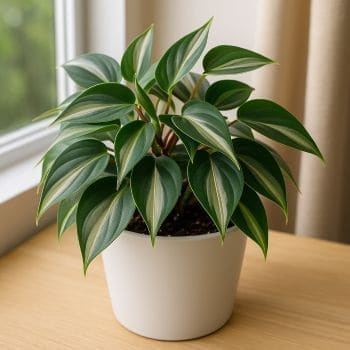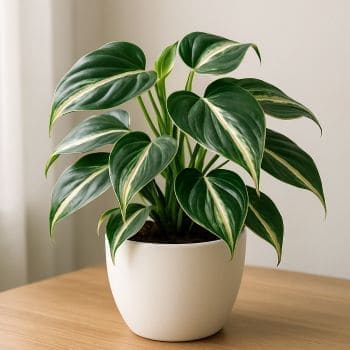Philodendron hederaceum ‘Rio’ Care & Growing Guide
Overview
Philodendron hederaceum ‘Rio’ is a striking variegated cultivar of the popular heartleaf philodendron, native to the tropical regions of South America. Known for its elongated, heart-shaped leaves adorned with silver, cream, and light green streaks over a deep green base, the ‘Rio’ is prized among houseplant enthusiasts for its beauty and relatively easy care. This trailing or climbing aroid adapts well to indoor conditions, making it a versatile choice for shelves, hanging baskets, or trained up supports.
In its native habitat, this philodendron grows as an understory plant, climbing trees in warm, humid environments. Indoors, it thrives in bright, indirect light and moderate watering, rewarding attentive care with lush growth and vivid variegation.
Identification & Growth Habit
The ‘Rio’ shares the classic heartleaf shape of Philodendron hederaceum but features a distinctive central silver stripe flanked by lighter green or cream, creating a painterly effect. Leaves are typically 3–6 inches long, with mature plants producing longer, more tapered foliage under optimal conditions.
This plant can be grown as a trailing vine cascading from a container, or as a climber when given a moss pole, trellis, or other vertical support. Growth is moderate; in the right conditions, vines can extend several feet in a season.
Light & Placement
- Optimal light: Bright, indirect light is best to maintain strong variegation.
- Lower light tolerance: Can survive in medium light but may revert to greener leaves.
- Avoid: Harsh direct sun, which can scorch foliage.
Place near an east- or north-facing window, or a few feet back from a bright south- or west-facing window with sheer curtains. Rotate the pot every few weeks to encourage even growth.
Watering & Humidity
Allow the top 2–3 inches of soil to dry out before watering. Check moisture with your finger or a moisture meter. Water thoroughly until excess drains from the pot’s holes, then discard any standing water in the saucer.
Humidity: Prefers 50–60% relative humidity. If your indoor air is dry, especially in winter, increase humidity with:
- A room humidifier
- A pebble tray with water beneath the pot
- Grouping plants together to create a microclimate
Soil & Repotting
Use a well-draining aroid mix that retains some moisture without becoming soggy. A recommended blend is:
- 1 part peat or coco coir
- 1 part perlite
- 1 part orchid bark
Repot every 2–3 years or when roots circle the pot’s interior. Choose a container with drainage holes and only size up by 1–2 inches in diameter to prevent waterlogging.
Fertilizing
Feed with a balanced, water-soluble fertilizer (e.g., 20-20-20) every 4–6 weeks during the active growing season (spring through early autumn). Dilute to half the recommended strength to avoid root burn. Suspend feeding in winter when growth slows.
Pruning & Training
Prune to control size, remove leggy growth, and encourage bushier vines. Use clean, sharp scissors or pruners, cutting just above a leaf node.
For a climbing display, train stems onto a moss pole or trellis, securing them gently with plant ties. Climbing growth often produces larger leaves and more pronounced variegation.
Propagation
Philodendron ‘Rio’ is easily propagated via stem cuttings. Follow these steps:
- Select a healthy vine with at least 2–3 leaves and visible nodes.
- Using sterilized scissors, cut just below a node.
- Remove the lowest leaf to expose the node.
- Place the cutting in a jar of clean water or directly into moist aroid mix.
- If rooting in water, change the water every few days to prevent stagnation.
- Once roots are 2–3 inches long, pot into soil and resume normal care.
Common Problems
Pests
- Spider mites: Look for fine webbing and speckled leaves. Treat with insecticidal soap or neem oil.
- Mealybugs: White, cottony clusters on stems and leaf joints. Remove manually and treat with horticultural oil.
- Aphids/scale: Wipe off and apply appropriate insecticide if infestation persists.
Diseases
- Root rot: Caused by overwatering or poor drainage. Remove affected roots and repot in fresh, well-draining mix.
- Leaf spot: Brown or yellow lesions may indicate fungal or bacterial issues. Remove affected leaves and improve air circulation.
Toxicity & Pet Safety
Philodendron ‘Rio’ contains calcium oxalate crystals and is toxic if ingested by humans, cats, or dogs. Keep out of reach of pets and children, and wear gloves if you have sensitive skin when pruning.
Styling & Decor Tips
- Display in a hanging basket to showcase trailing vines.
- Use a tall planter with a moss pole for a vertical accent.
- Pair with solid-colored pots to highlight the variegation.
- Place near other tropicals for a lush, layered look.
Varieties & Cultivars
The ‘Rio’ is a sport of Philodendron hederaceum ‘Brasil’, distinguished by its cooler-toned silver variegation. Related cultivars include:
- ‘Brasil’: Yellow-green variegation.
- ‘Silver Stripe’: Similar to ‘Rio’ but with narrower silver bands.
- ‘Cream Splash’: Creamy variegation with less silver.
Buying Tips & Maturity
When purchasing, look for plants with multiple vines, firm leaves, and clear variegation. Avoid specimens with mushy stems or yellowing leaves. Younger plants may have smaller leaves and less pronounced variegation; as they mature and climb, leaf size and color definition often improve.
Seasonal Care
- Spring/Summer: Active growth; maintain consistent watering and fertilize regularly.
- Autumn: Gradually reduce feeding; monitor for reduced water needs.
- Winter: Growth slows; water less frequently and maintain humidity to counteract dry indoor air.
FAQ
How fast does Philodendron ‘Rio’ grow?
Growth is moderate; with good light and care, expect several inches to a foot of new vine length per season.
Can Philodendron ‘Rio’ live in low light?
It can survive in medium to low light but may lose variegation, producing mostly green leaves.
Should I mist my Philodendron ‘Rio’?
Occasional misting can help, but raising room humidity is more effective for sustained health.
Why are my ‘Rio’ leaves turning yellow?
Common causes include overwatering, poor drainage, or sudden changes in temperature/light.
Can I grow Philodendron ‘Rio’ outdoors?
Only in warm, frost-free climates with filtered light; otherwise, keep it as a houseplant.






